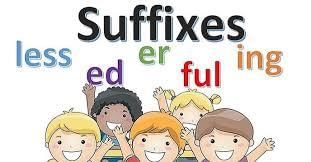Grade 12 Exam > Grade 12 Notes > Language Arts for Grade 12 > Suffixes and how to use them
Suffixes and how to use them | Language Arts for Grade 12 PDF Download
What is a Suffix?
- A suffix is a letter or group of letters that is added to the end of a word to change its meaning.
- Some suffixes have specific functions. For instance, adding '-ing' can transform a noun into a verb. For example, "garden" can become "gardening."
- Similarly, adding '-ed' can convert a verb into the past tense. For instance, "jump" can change to "jumped."

Suffix Spelling Rules
When using suffixes like '-er', '-ing', '-est', '-ed', and '-y', there are four key spelling rules to keep in mind:
- The suffix '-er' is added to nouns to indicate a person or thing that performs an action. For example, "teacher" or "dancer."
- When adding '-ing', remember to drop the 'e' at the end of the base word if it has one before adding 'ing'. For example, "write" becomes "writing."
- For '-est', you add it to adjectives to indicate the superlative form. For instance, "big" becomes "biggest."
- When adding '-ed' to a verb, it usually indicates that the action has already happened in the past. For example, "play" changes to "played."
Suffix Spelling Rules
- Rule 1: For words ending in two consonants, simply add the suffix to the root word.
- Example: smart + er = smarter
- Rule 2: For words ending in a short vowel sound followed by a consonant, double the last letter before adding the suffix.
- Example: mop + ed = mopped
- Rule 3: If a word ends in a consonant followed by 'e', drop the 'e' before adding the suffix.
- Example: stride + ing = striding
- Rule 4: When a word ends in a consonant and 'y', change 'y' to 'i' before adding the suffix, unless the suffix starts with an 'i'.
- Example: cry + ed = cried
- Example: cry + ing = crying
Understanding Spelling Rules
- Vowels and Consonants: Vowels are essential in spelling. They are the letters a, e, i, o, and u. Consonants, on the other hand, encompass all the other letters of the alphabet.
- Example: In the word "elephant," the vowels are 'e' and 'a,' while the consonants are 'l,' 'p,' 'h,' 'n,' and 't'.
- Root Words: Understanding root words is fundamental for spelling accuracy. Root words are the basic, original words from which other words are formed, without any prefixes or suffixes added.
- Example: The root word "play" can give rise to words like "player," "playing," and "playful" when affixes are added.
Question for Suffixes and how to use themTry yourself: Which spelling rule requires you to double the last letter before adding a suffix when the word ends in a short vowel sound followed by a consonant?View Solution
The document Suffixes and how to use them | Language Arts for Grade 12 is a part of the Grade 12 Course Language Arts for Grade 12.
All you need of Grade 12 at this link: Grade 12
|
43 videos|132 docs|32 tests
|
Related Searches




















